Tuna kimbap is a popular Korean lunchbox roll made with creamy tuna, cucumber, and pickled radish. This easy no-cook recipe is perfect for beginners—light, satisfying, and packed with savory flavor. Great for picnics, road trips, or quick meals.
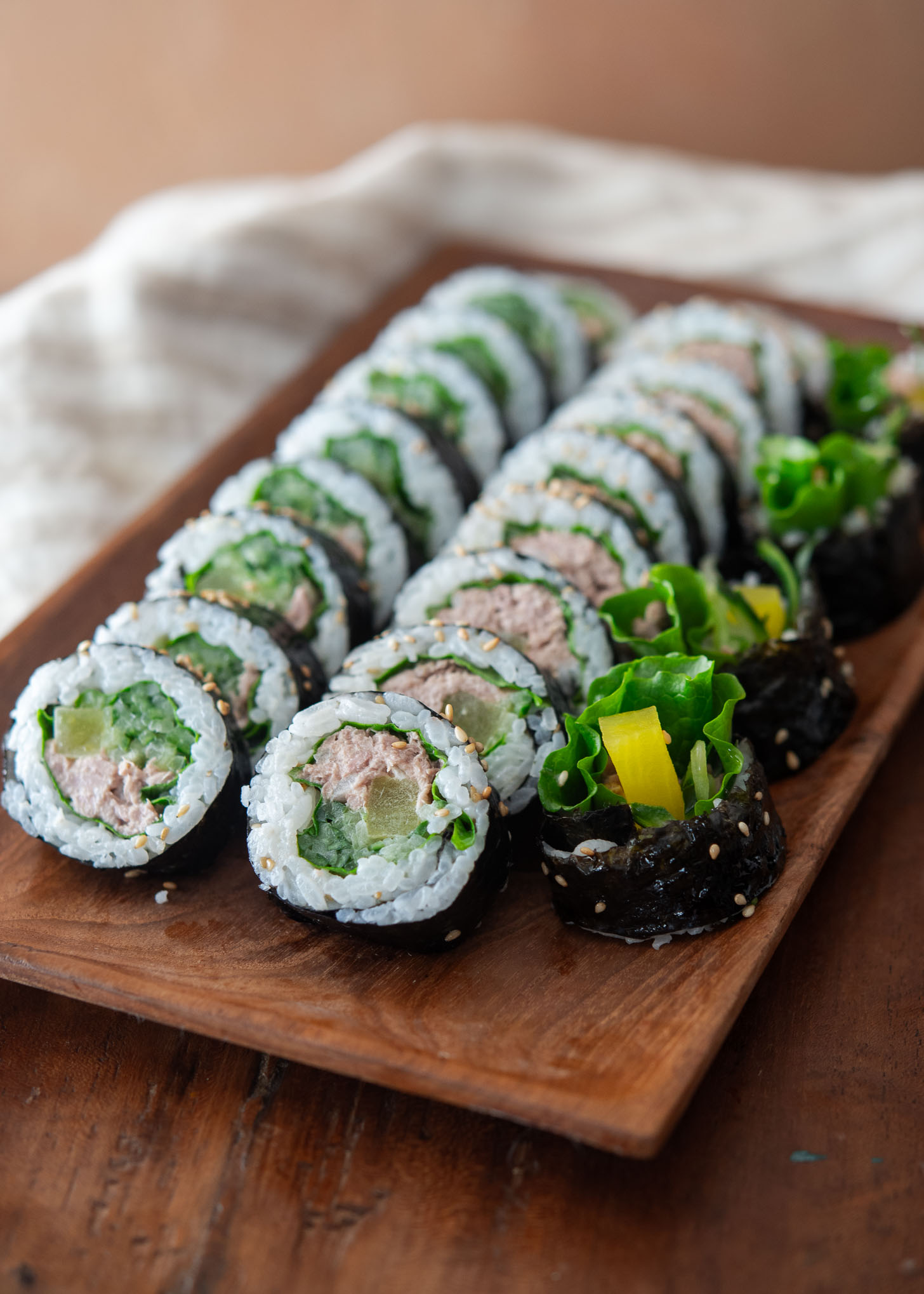
Tuna kimbap (chamchi gimbap, 참치김밥) is one of Korea’s most popular kimbap variations—found everywhere from convenience stores to lunchboxes and picnic baskets. Think of it as Korea’s take on sushi rolls, but with a creamy tuna mayo filling and no wasabi surprises.
Unlike recipes that pile on a dozen fillings, this version keeps it simple: tuna, cucumber, pickled radish, and lettuce, all rolled with rice and seaweed. It requires no cooking (aside from rice—or leftovers work), making it perfect for lunchboxes, picnics, or anyone craving a light, flavorful bite.
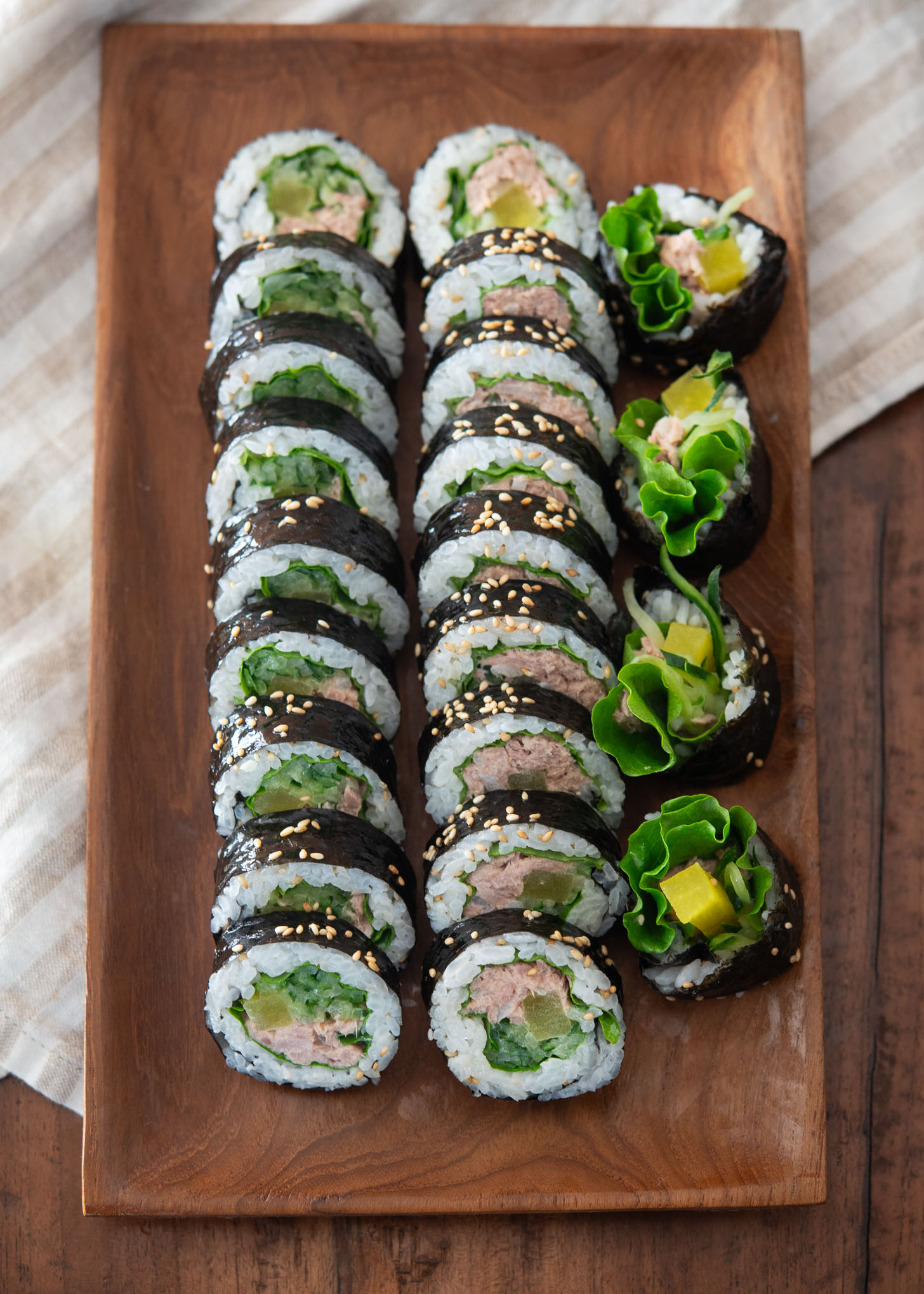
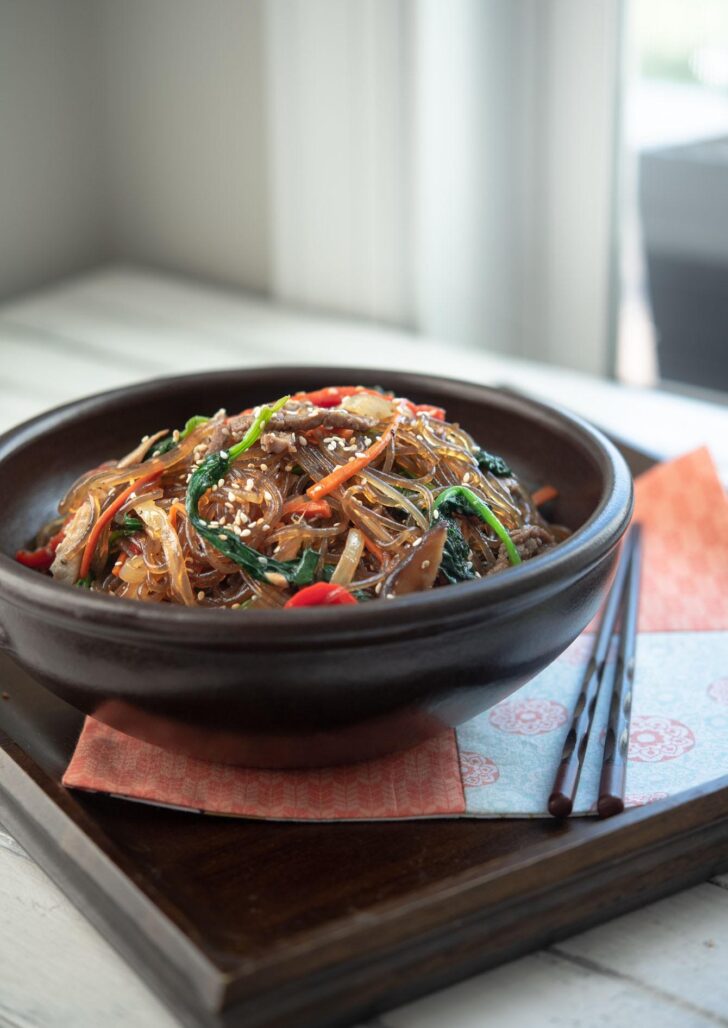
Get new recipes via email:
I first made this for my massage therapist, who often skips lunch. I packed these little tuna rice rolls as tidy finger food she could grab between appointments. After one bite, she said it was “better than the fancy ones with 10 fillings!” She devoured the rest and asked for the recipe before I left.
This homemade tuna kimbap is light, satisfying, and hands down one of the best kimbap recipes for beginners—easy to roll, even easier to love.
Ingredients for Tuna Kimbap (with Tips)
Here’s a closer look at the key ingredients that make this easy tuna kimbap recipe so satisfying—and how to choose the best ones for authentic flavor and great texture.
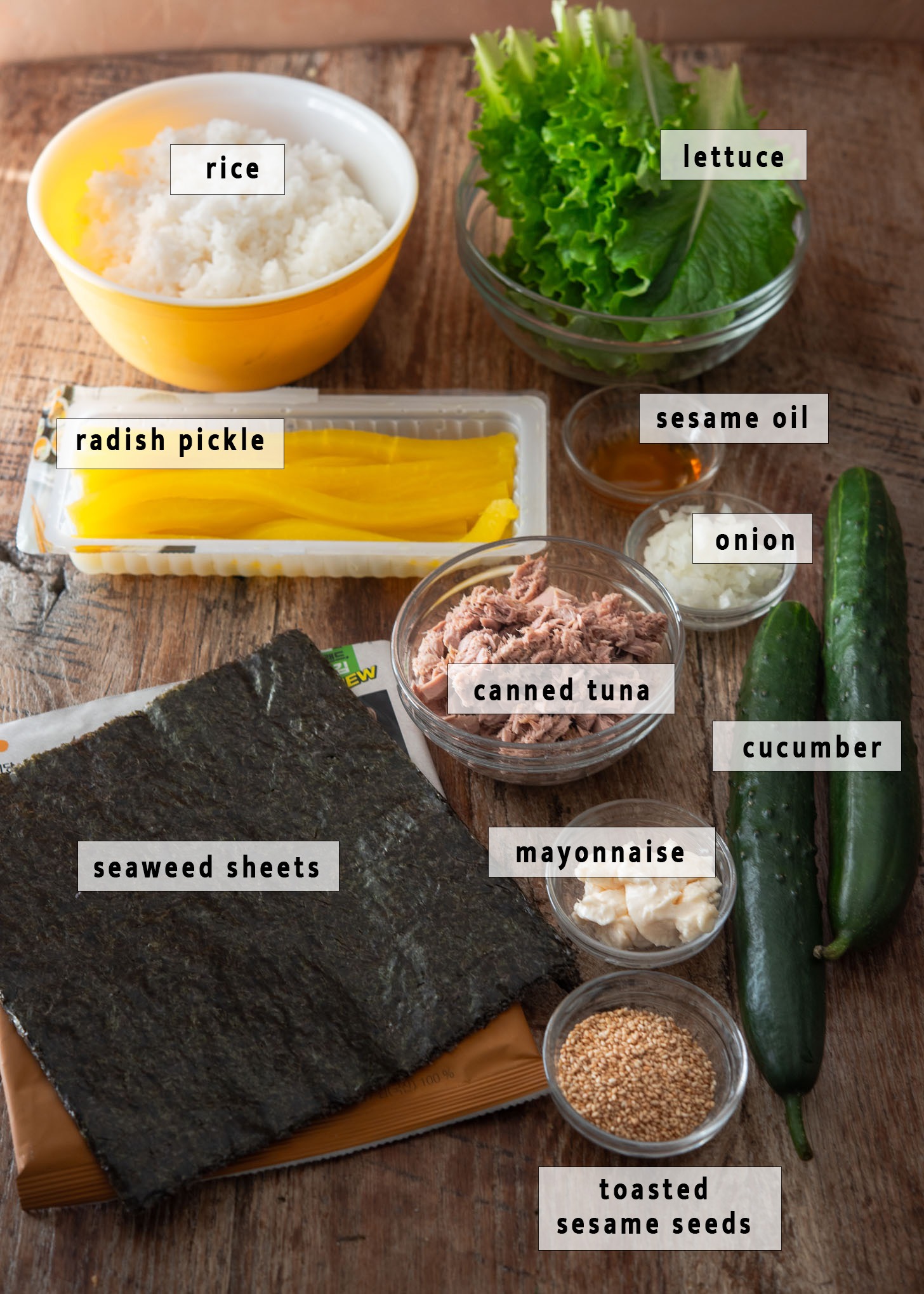
- Dried seaweed (gim / nori): For any kimbap roll, you’ll need sheets of roasted seaweed. Look for ones labeled gim (Korean) or sushi nori in Asian markets. I recommend the slightly thicker, shiny kind—they hold up better when rolling and don’t tear as easily.
- Canned tuna (chunk style): This is the star of the show. Use chunk light tuna (in oil or water—just be sure to drain it really well). I mix it with a spoonful of mayo and a pinch of chopped onion for extra umami and a hint of crunch. It’s simple, savory, and exactly what you want in a Korean tuna kimbap filling.
- Cucumber: I’ve tested both fresh and salted cucumber, and the quick salting method wins—it keeps the cucumber crisp, removes that raw edge, and helps prevent excess moisture from seeping into the kimbap roll.
- Pickled radish (danmuji): Danmuji brings a pop of brightness that cuts through the creamy tuna. Its tangy-sweet bite is classic in Korean lunchbox foods. You’ll find it in the refrigerated section of Korean or Asian grocery stores—look for the bright yellow sticks. If you can’t find it, any mild pickled veggie will do, though the flavor will shift slightly.
- Lettuce: I like to add a fresh lettuce leaf, green leaf or romaine, to act as a natural barrier between the rice and filling. It keeps the tuna mixture from soaking into the rice and adds a nice crisp bite. Bonus: it makes rolling a little easier, too—and looks neat, too.
How to make Cucumber Tuna Kimbap (Step-by-Step)
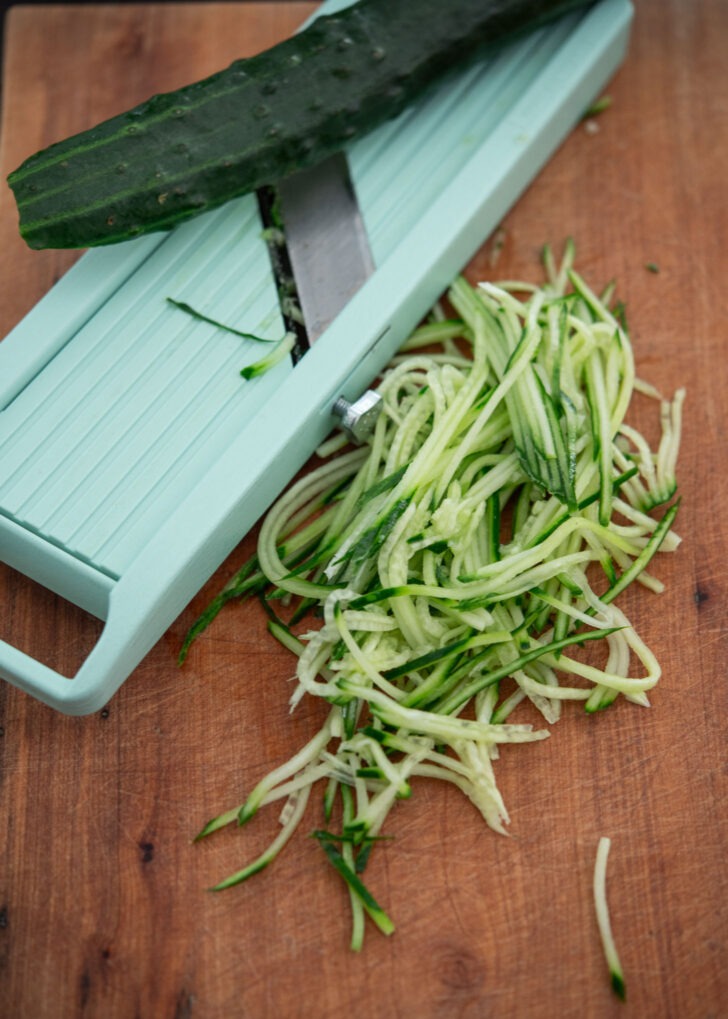
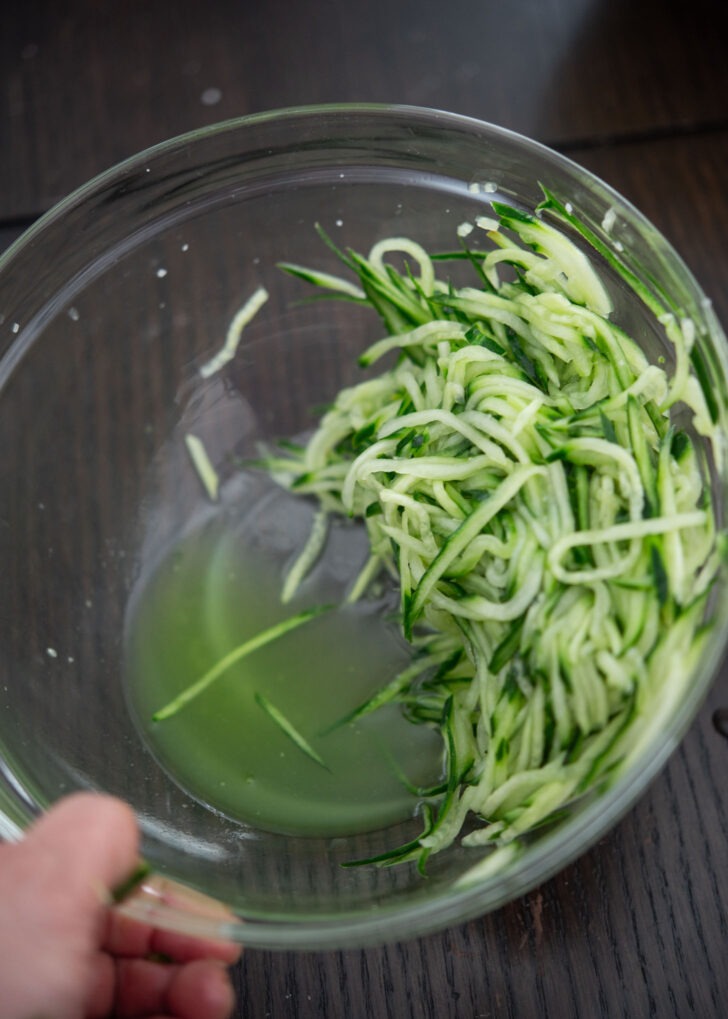
1. Salt the cucumber: Thinly slice cucumber (I use a mandolin for even cuts) and toss with salt. Let sit for 5 minutes, then gently squeeze out excess water.
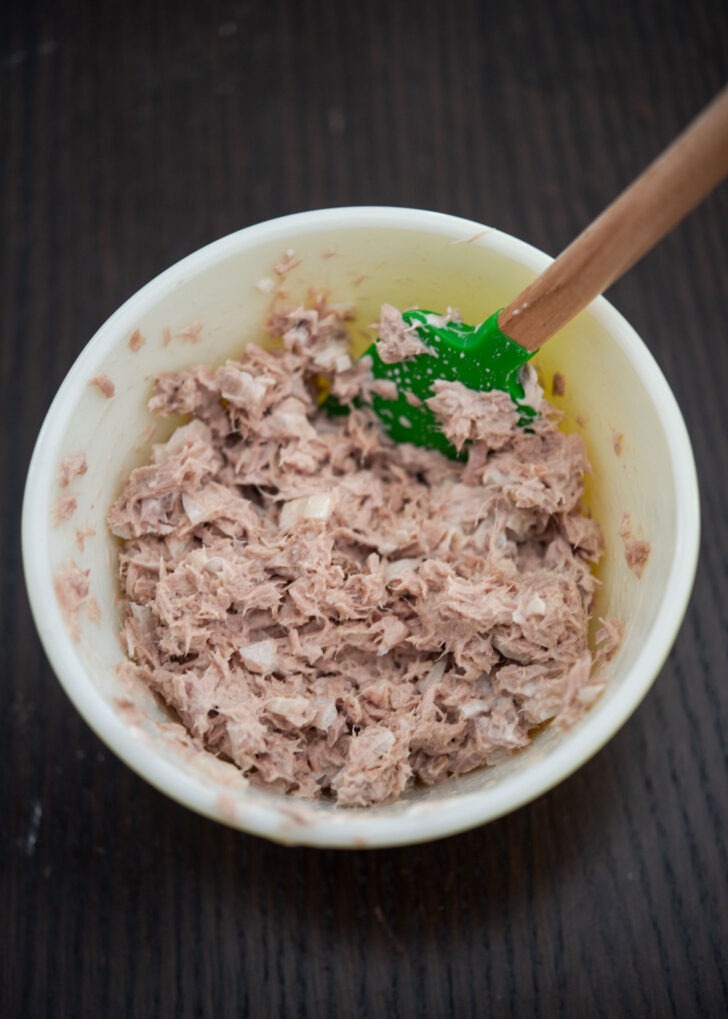
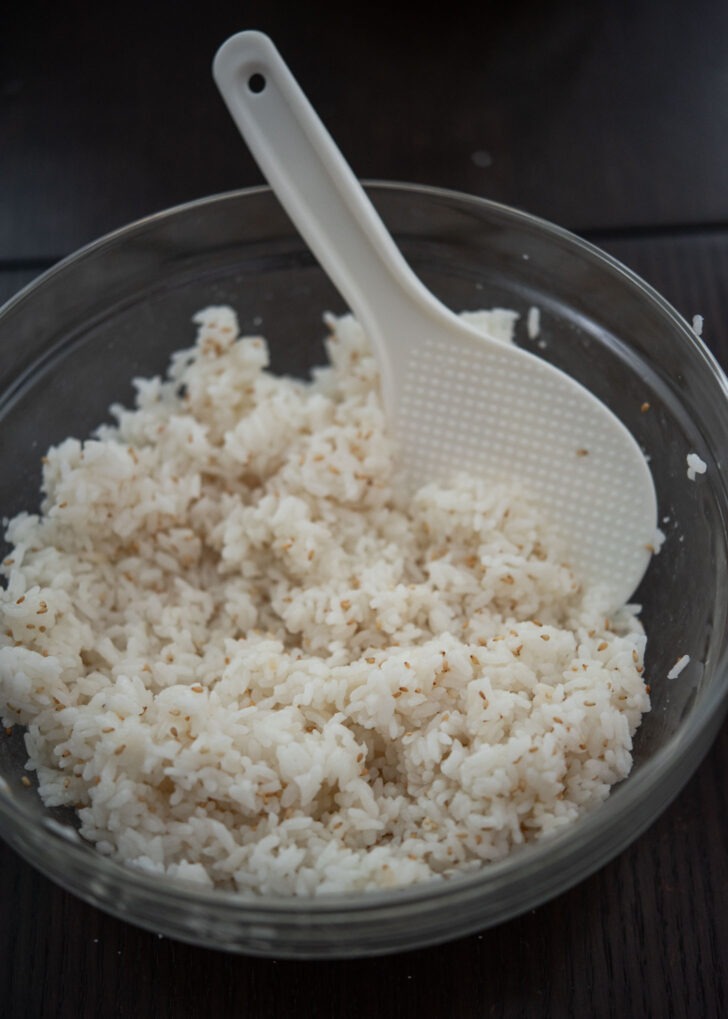
2. Prep tuna and rice: Mix drained chunk tuna with chopped onion and mayo. Season warm short grain rice with salt, sesame oil, and toasted sesame seeds for that signature kimbap flavor.
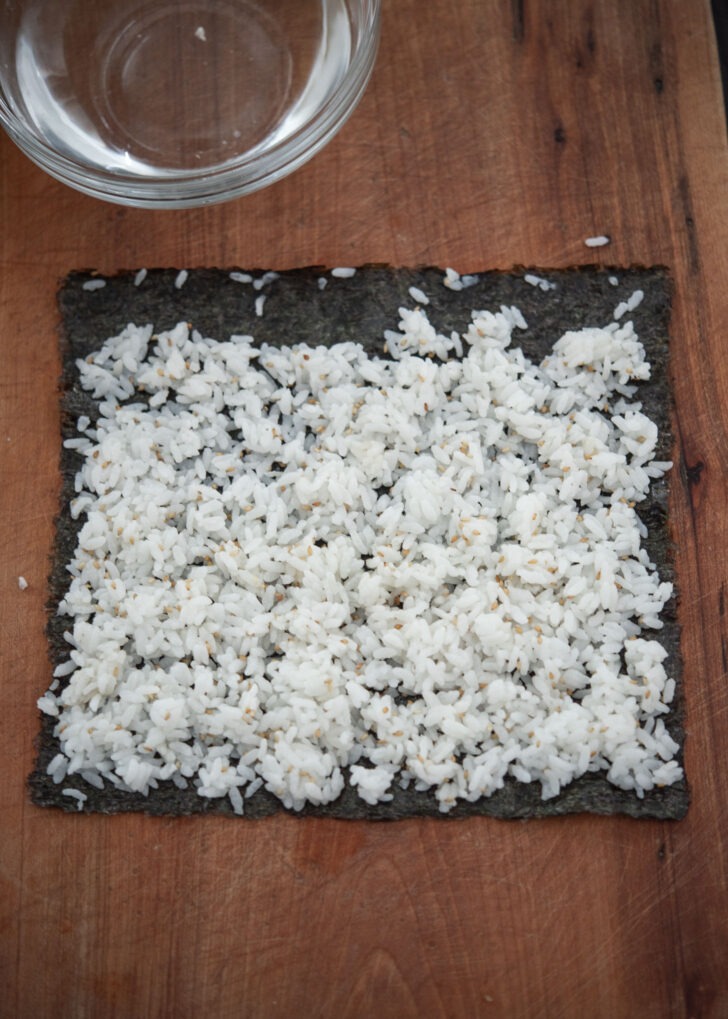
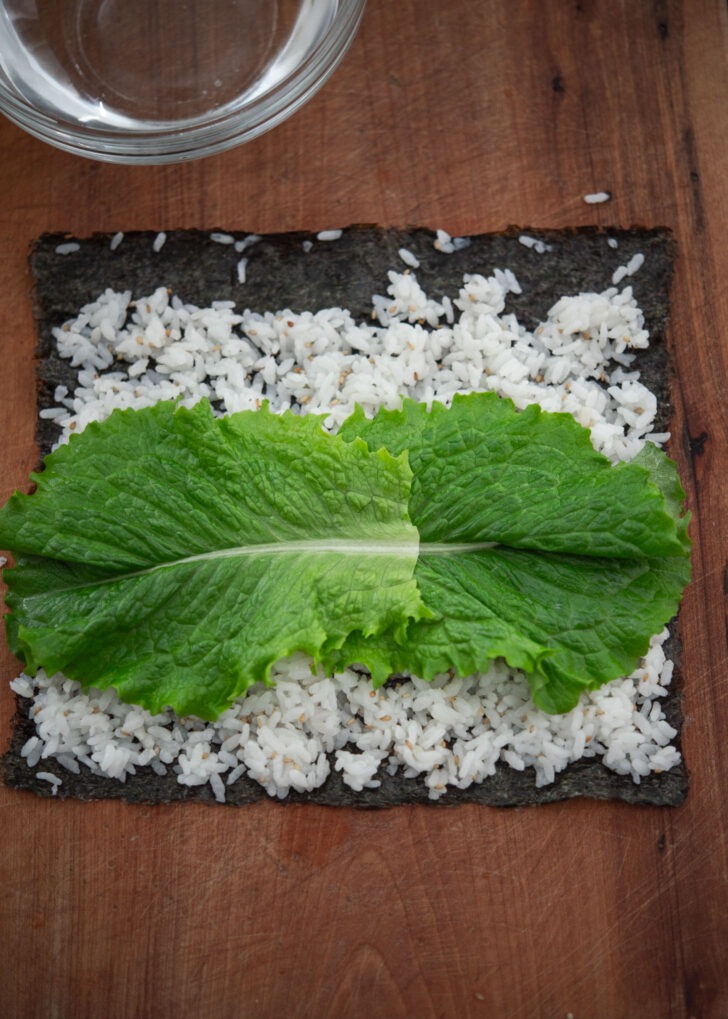
3. Spread rice on seaweed: Lay a seaweed sheet shiny-side down. Spread about 1 cup of rice evenly across, leaving a small gap at the top. Add two pieces of lettuce over the rice (bottom third).

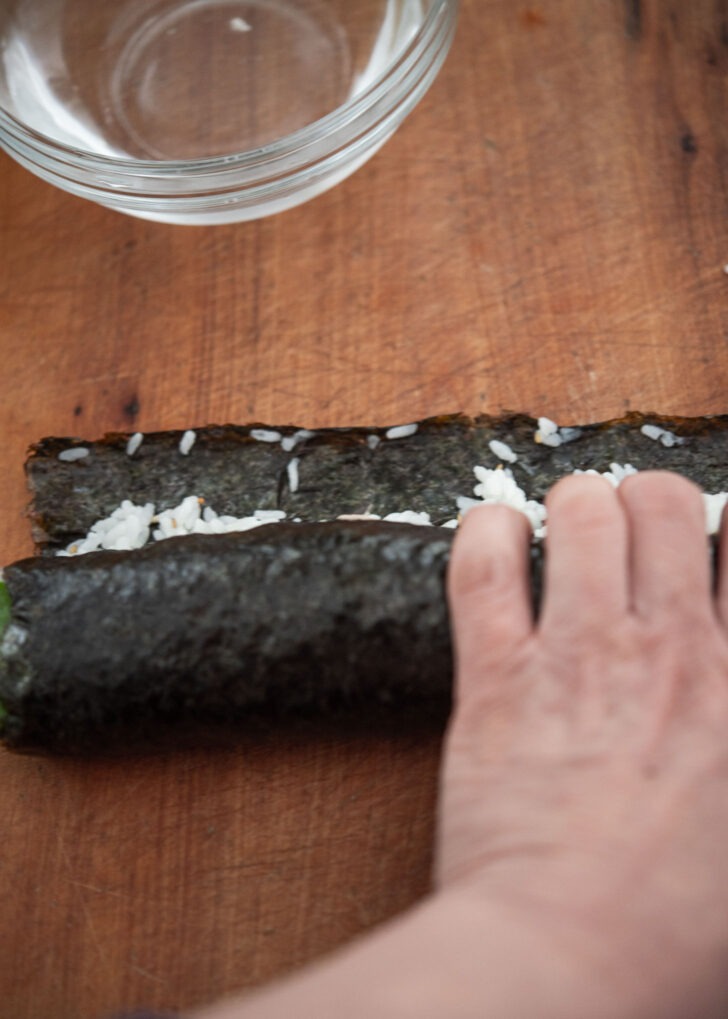
4. Add filling and roll: Place the tuna mixture, cucumber, and a strip of pickled radish on top of the lettuce. Keep the fillings centered to make rolling easier and avoid overflow.
Start with a tight first fold, tucking the ingredients firmly as you go. Apply light pressure as you roll to keep everything compact. Watch the tutorial video below if you need a quick visual cue.
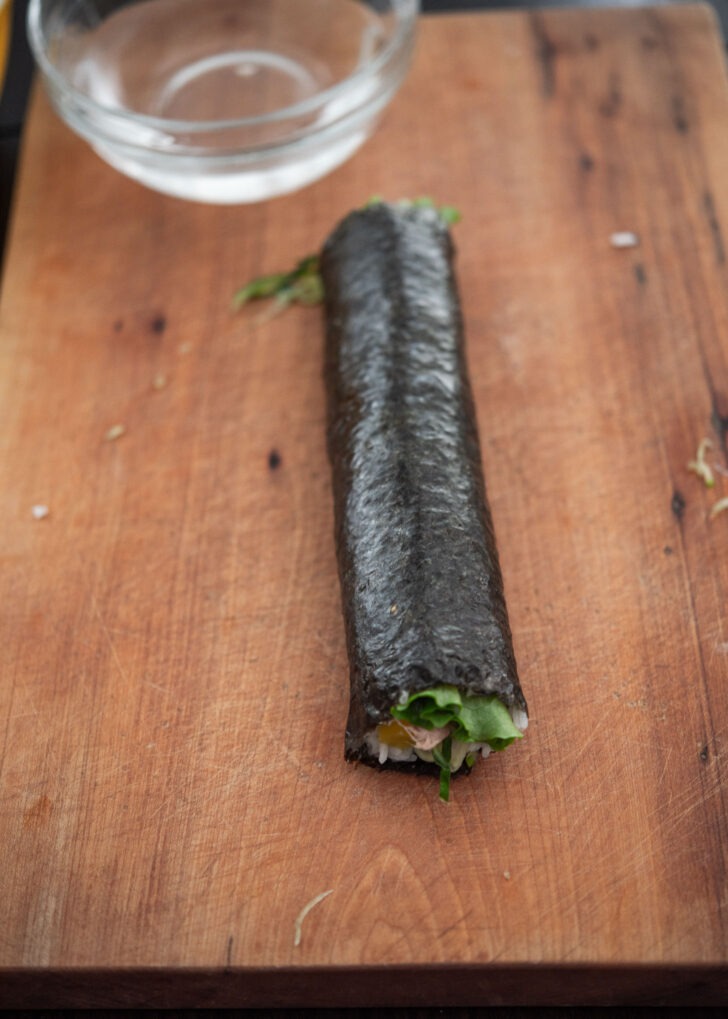
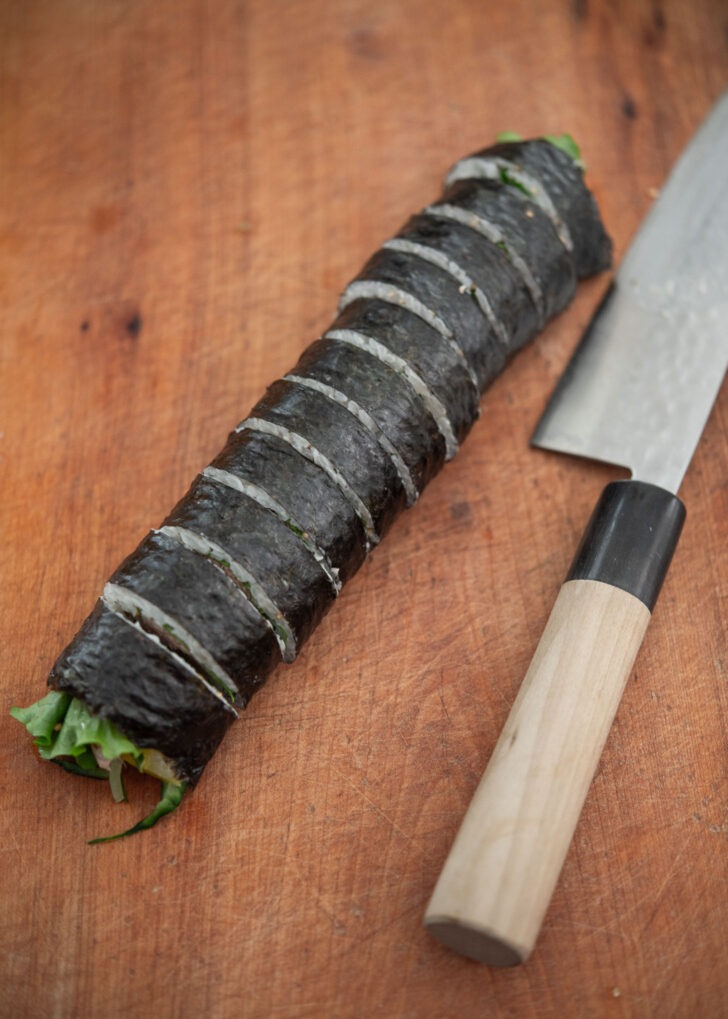
5. Slice and serve: Brush a sharp knife with sesame oil and slice the roll into ½-inch pieces, wiping the blade between cuts for clean edges.
If you love that nutty sesame aroma, brush a little sesame oil on the roll before slicing, and finish with a sprinkle of toasted sesame seeds for that glossy, classic kimbap look.
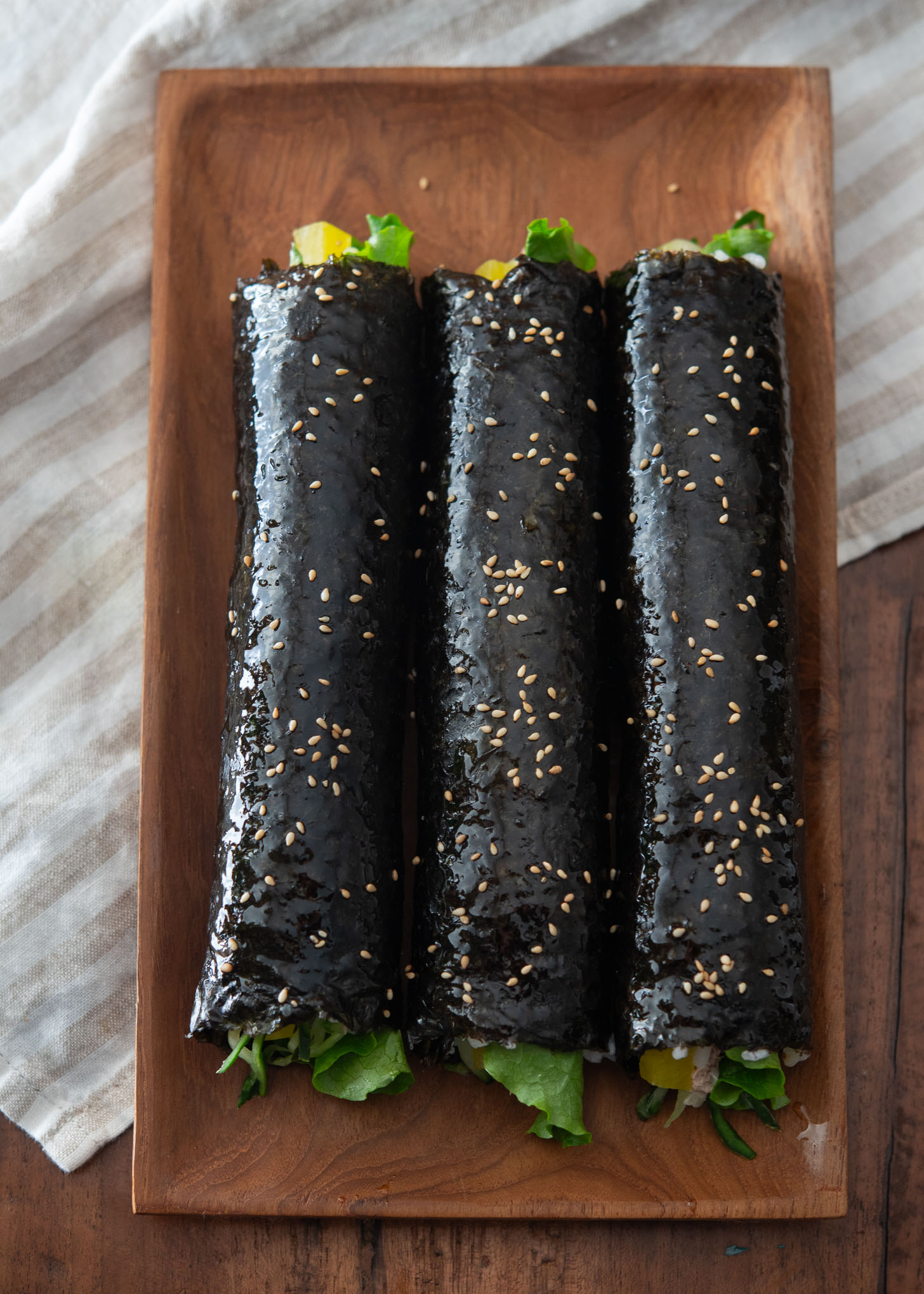
Helpful Tips for Rolling Kimbap
- Be careful not to overfill the ends with tuna to prevent spillage during rolling.
- Refrain from filling the kimbap too much, as it could cause the roll to burst open when you cut it.
- The initial roll is crucial; hold the fillings securely to keep them in place. Once you’ve made the first wrap, gently press to shape the roll, then finish rolling. A firm final squeeze ensures the roll maintains its shape.
- If you’re not comfortable rolling with your hands, use a bamboo sushi mat to firm up the roll.
More Rice Rolls Recipes
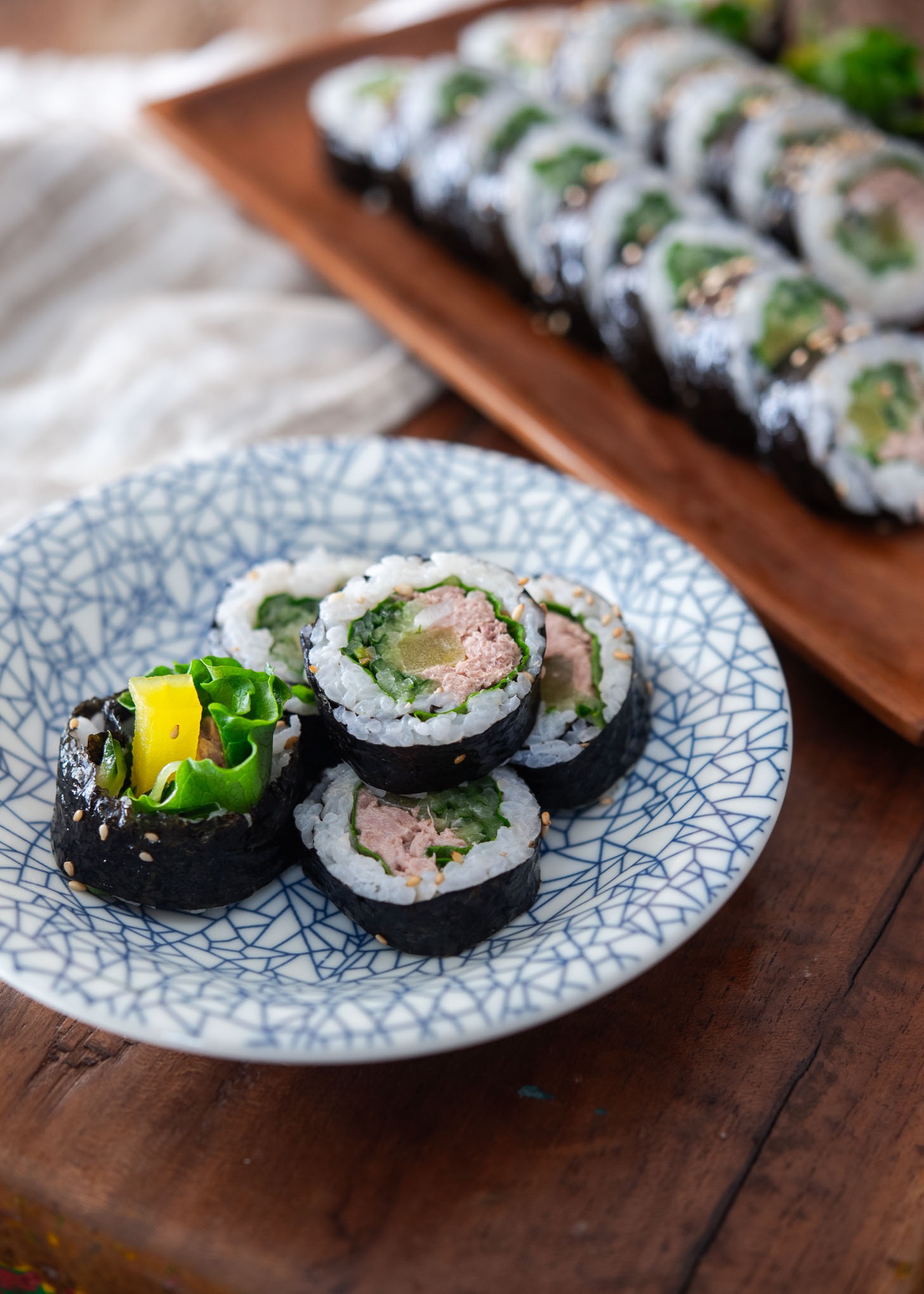
Love this recipe? Rate it and share your experience in the comments below! On Instagram? Tag me to showcase your creation. For more delicious recipes, subscribe to our newsletter!
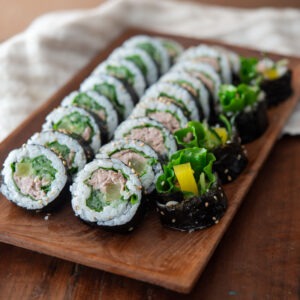
Easy Tuna Kimbap (Cucumber Chamchi Gimbap)
Easy tuna kimbap with creamy tuna, cucumber, and pickled radish. A no-cook Korean rice roll perfect for beginners, lunchboxes, or light meals.
For tuna
- 2 5-oz each canned tuna
- 2 tbsp minced onion
- 2 tbsp mayonnaise
For other ingredients
- 1 English cucumber, or 2 Kirby cucumber
- 1 tsp kosher salt
- 8 romain lettuce leaves, Use only green part
- 4 strips radish pickle
- extra sesame oil and sesame seeds, for ganish
For cucumber
-
Thinly slice the cucumber using a mandolin slicer or knife. Place them in a large bowl, sprinkle salt over the cucumber strips, toss, and let them sit for 5 minutes to draw out moisture. After they’ve sat, gently squeeze out the excess water. This step ensures the cucumbers remain crisp and well seasoned. Transfer the cucumber to a bowl.
For rice
-
Season the cooked rice by mixing in salt, sesame oil, and toasted sesame seeds in a large mixing bowl.
Assembling kimbap
-
Lay a sheet of seaweed (gim), shiny side down, on a cutting board or clean surface with the longer edge facing you. Evenly spread about 1 cup of rice over the seaweed. If the rice sticks, wet your fingers slightly with water.
-
Place two lettuce leaves at the edge closest to you on top center of the rice, followed by the tuna mixture and cucumber strips on top of lettuce. Add a strip of radish pickle for an extra tangy crunch.
-
Carefully roll the seaweed over the fillings, using both hands to tuck in the ingredients. Apply gentle pressure to ensure the kimbap roll is tight and compact. If you’re not comfortable rolling with your hands, use a bamboo sushi mat to firm up the roll.
-
For a glossy finish, brush the roll with a touch of sesame oil and sprinkle with toasted sesame seeds. Before slicing the roll into bite-sized pieces, apply a little bit of sesame oil to a sharp knife to prevent sticking. Cut the roll into 1/2-inch bite sizes. Clean the knife with a damp towel when needed and apply oil again.
- For optimal results, use white short-grain or medium-grain rice. Make sure your rice is cooled down to the room temperature if using freshly cooked rice. Too-hot rice can make the seaweed shrink and soggy.
- Avoid stuffing too much, or the roll may tear during slicing.
- Roll firmly but gently—start with a secure first fold to hold everything in place.
For Storage: For best flavor and texture, enjoy the kimbap the day it’s made or by the next day. Store in an airtight container in the fridge, and slice just before serving to prevent the rice from drying out.
Calories: 305kcal, Carbohydrates: 50g, Protein: 6g, Fat: 9g, Saturated Fat: 1g, Polyunsaturated Fat: 5g, Monounsaturated Fat: 2g, Trans Fat: 0.01g, Cholesterol: 3mg, Sodium: 780mg, Potassium: 323mg, Fiber: 3g, Sugar: 2g, Vitamin A: 4961IU, Vitamin C: 5mg, Calcium: 68mg, Iron: 1mg
